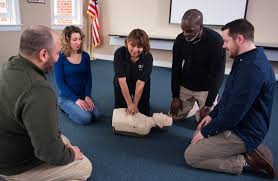Introduction
In our busy world, emergency situations can strike without caution. Whether it's a minor injury, a medical emergency situation, or a life-threatening situation, knowing just how to offer first aid can make all the difference. This is where a First Aid course comes into play. Lots of people might question what they can obtain from such training, and this article intends to shed light on that.
By register in a First Aid and mouth-to-mouth resuscitation course, you don't just find out about wrapping wounds or doing mouth-to-mouth resuscitation; you outfit on your own with indispensable skills that could conserve lives. So, exactly what will you learn in an extensive training course? Let's study the details.
First Aid Fundamentals: What You'll Discover in a Thorough Course
Understanding First Aid
What is Initial Aid?
First help describes the initial assistance provided to someone struggling with an injury or disease till professional clinical assistance gets here. It encompasses different strategies and skills varying from straightforward injury care to lifesaving techniques like CPR (Cardiopulmonary Resuscitation).
Importance of Emergency treatment Training
Why Must You Take an Emergency Treatment Course?

Taking a First Help course is necessary for numerous reasons:
- Confidence: Knowing exactly how to react in emergencies can infuse confidence. Life-Saving Skills: The capability to carry out CPR or assist with choking can save lives. Career Improvement: Several professions call for certification in very first aid. Community Duty: Being trained means you can help others effectively.
Overview of CPR
What is CPR?
CPR, or Cardiopulmonary Resuscitation, is an emergency situation treatment carried out when someone's heart beat or breathing has actually stopped. It incorporates upper body compressions with rescue breaths to keep blood circulation and oxygenation until expert aid arrives.
The Structure of a Comprehensive First Aid Course
What Does an Emergency treatment Course Include?
An all-round First Help and CPR course normally covers the following subjects:
Introduction to First Aid Legal and Honest Considerations Scene Safety Basic Life Support (BLS) CPR Techniques Choking Relief Wound Treatment Management Burn Treatment Managing Shock Recognizing Medical Emergencies Using an Automated External Defibrillator (AED)Legal Elements of First Aid
Are There Legal Ramifications Involved in Providing First Aid?
Yes, giving first aid does lug legal responsibilities called "Do-gooder regulations." These laws safeguard individuals who help others in emergencies, provided their actions are practical and not reckless.
Scene Security: The First Step
How Do You Make sure Scene Safety?
Ensuring scene safety and security involves assessing the atmosphere before coming close to the sufferer:
- Look for prospective dangers (web traffic, fire). Make certain it's safe for both you and the victim.
Basic Life Support (BLS)
What Role Does BLS Play in Emergency Situations?

Basic Life Support includes the fundamentals of keeping life features until more medical help shows up. This Visit the website area covers vital abilities such as:
- Checking responsiveness Activating emergency solutions Performing top quality upper body compressions
Advanced mouth-to-mouth resuscitation Techniques
What Are Advanced Techniques Covered in Mouth-to-mouth Resuscitation Courses?
Advanced techniques might include:
- Two-rescuer CPR Use of barrier tools for rescue breaths Special factors to consider for babies and youngsters
Choking Alleviation Techniques
How Do You Help A Person That is Choking?
Choking relief involves 2 crucial techniques:
The Heimlich maneuver for adults. Back blows and upper body drives for infants.Wound Treatment Management
How Do You Properly Handle Wounds?
Effective injury management includes:
- Cleaning the injury with saline or clean water. Applying antibiotic ointment. Covering it with sterile dressings.
Burn Treatment
What Work Methods for Treating Burns?
Burn treatment varies by degree:
Cool the shed under running water. Cover it with non-stick dressings. Seek clinical attention for extreme cases.Managing Shock
How Is Shock Identified and Treated?
Recognizing shock includes seeking signs and symptoms like light skin, rapid pulse, or confusion:
Lay the individual down. Elevate their legs unless there are injuries avoiding this. Keep them relax till assistance arrives.Recognizing Clinical Emergencies
What Types of Medical Emergencies Need To You Know Of?
Common medical emergency situations include:
- Heart strikes Stroke Severe allergies Comprehending these conditions aids you act quickly.
Using an Automated External Defibrillator (AED)
How Do You Utilize an AED Correctly?

Using an AED involves turning it on, affixing pads according to pictures on the device, and following voice triggers carefully.
Importance of Continuous Learning
Why Is Continual Understanding Important in First Aid Training?
Continuous knowing guarantees you stay upgraded on best methods and new methods in first aid care.
FAQs Concerning Emergency treatment Courses
What Is Included in a Criterion First Aid Course?- A basic course commonly covers fundamental life assistance, injury management, choking alleviation strategies, and lawful considerations.
- Most courses vary from 6 hours to 16 hours depending on the deepness of web content covered.
- Yes, upon effective conclusion of a lot of training courses, participants receive a first help certificate, which is generally legitimate for two years.
- Yes! Several companies provide on-line programs that provide adaptable learning environments while still being effective.
- Absolutely! Hands-on practice is vital for grasping skills like chest compressions and using AEDs effectively.
- Generally, there are no age limitations; however, individuals have to be mentally experienced to learn these life-saving abilities effectively.
Conclusion
Enrolling in a detailed first aid course outfits individuals with vital knowledge that can conserve lives during emergencies-- whether at home, job, or out in public areas! From recognizing basic life assistance procedures like mouth-to-mouth resuscitation to learning how to take care of injuries effectively or identify indicators of shock-- these courses provide indispensable training that any individual can benefit from!
As we browse through our daily lives full of changability-- what better way than preparing ourselves via knowledge obtained from organized training sessions concentrated on saving lives?
In verdict-- if you're considering occupying any kind of kind of first-aid training-- never ever hesitate! Outfit yourself today with these effective tools due to the fact that readiness genuinely makes all the distinction when every 2nd counts!